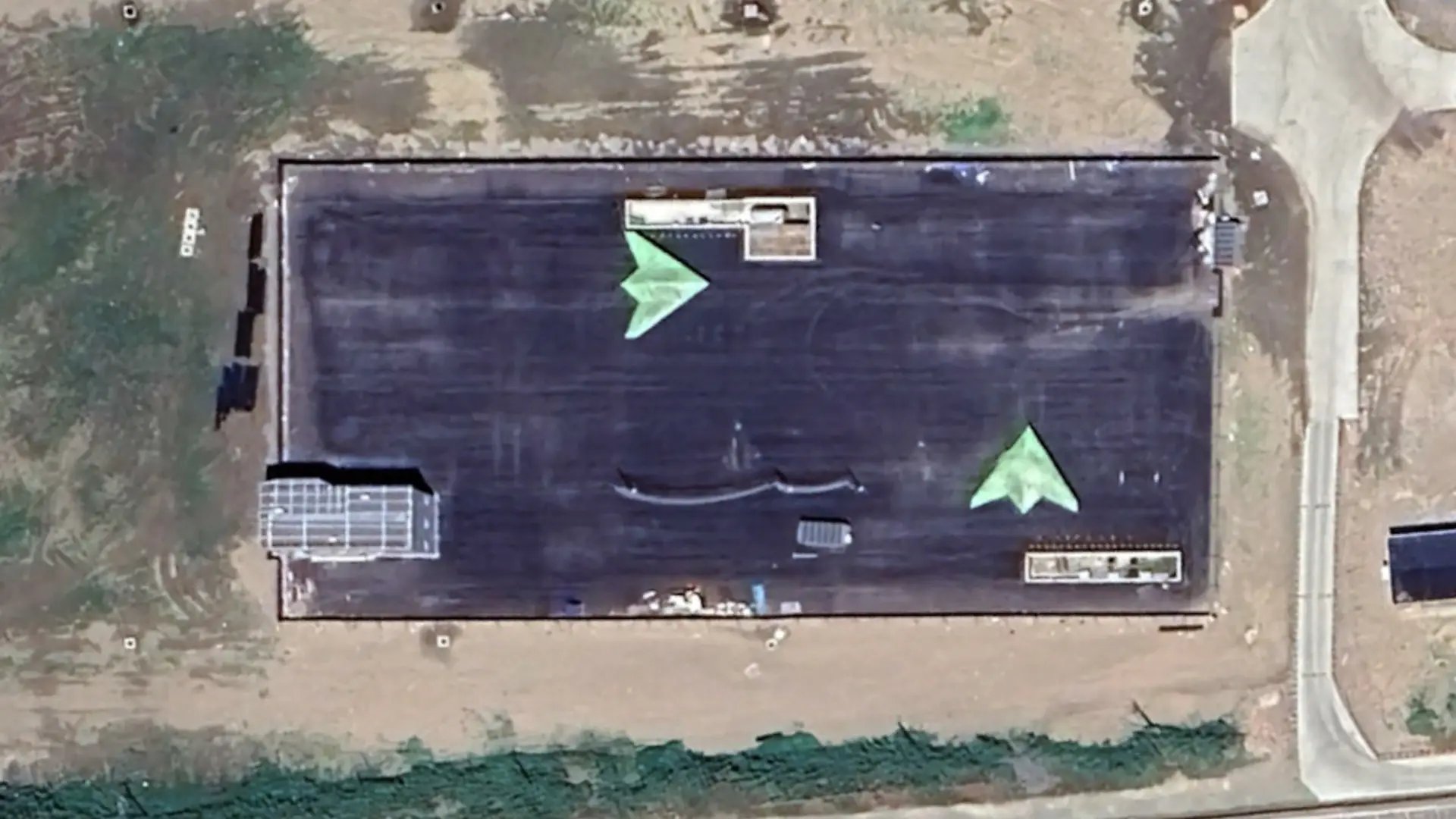Apparent mockups of China’s stealthy GJ-11 Sharp Sword unmanned combat aerial vehicle (UCAV) have emerged at a test and/or training site on Changxing Island in Shanghai. This adds to the growing evidence that the GJ-11, or a derivative thereof, is set to be part of future air wings for the People’s Liberation Army Navy’s carriers and newest big deck amphibious assault ships. The mockups are notably situated just over a mile away from where the first example of a new class of Chinese amphibious warship with a uniquely large flight deck, commonly referred to as the Type 076, is under construction.
Satellite imagery available through Google Earth shows a pair of green-colored UCAVs that match up completely in size and shape with the GJ-11 at the site at the far southeastern end of Changxing Island in May.
A review of additional satellite imagery from Planet Labs also shows the likely GJ-11 mockups there at around that time and indicates they have been there for some time now. Construction of the site itself, which includes a paved apron-like area where the drones are situated, along with other supporting facilities, only began last fall and looks to be ongoing in certain parts.
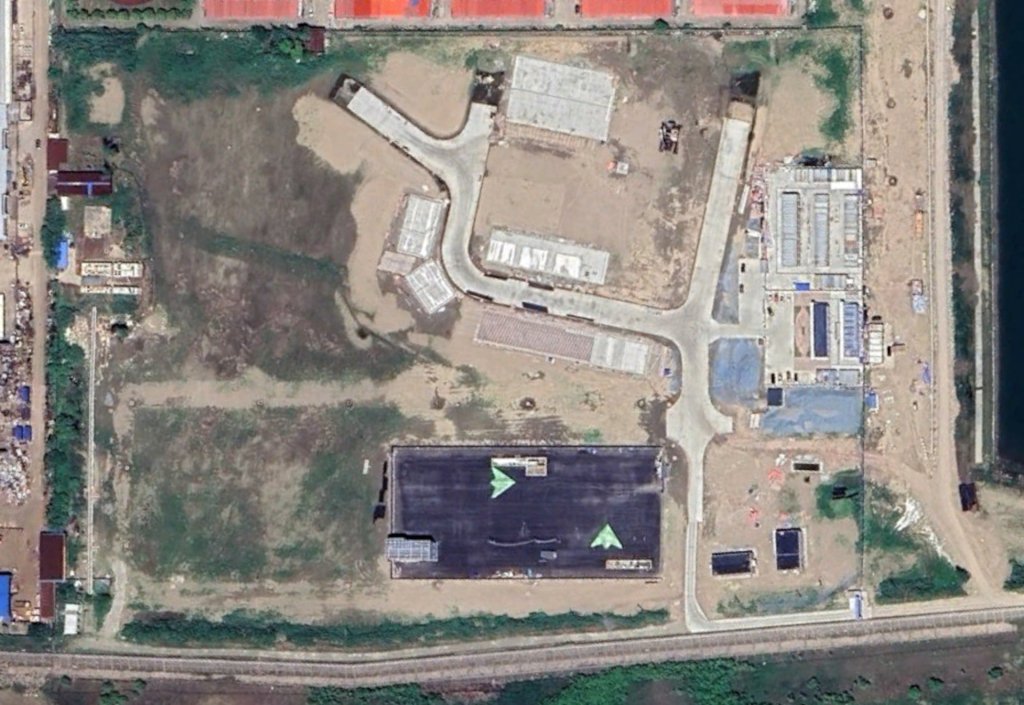
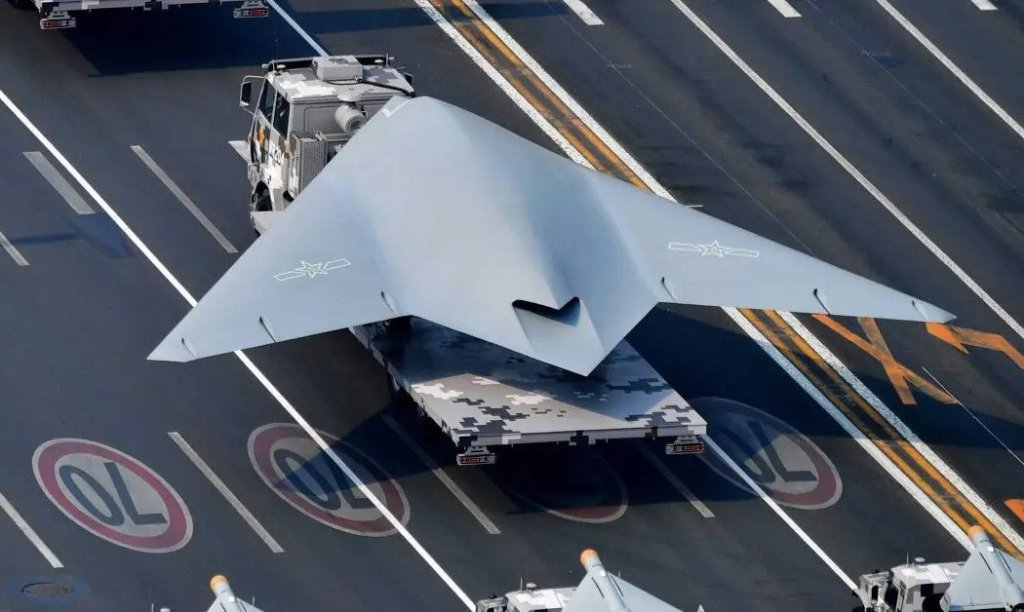
The apron is around 405 feet long and 200 feet wide. There are three distinct structures built on top of it. What may be a jet blast deflector is also present. The largest of the three could potentially be intended to reflect the island, or a portion thereof, on a carrier or a large deck amphibious assault ship.
It is worth noting that the dimensions of the apron at the site on Changxing Island do not directly align with the size of the Type 076’s deck, at least from what we can see so far, or that of any of China’s aircraft carriers. Separate satellite imagery indicates that the Type 076 will be around 141 feet wide and 864 feet long – which is still significantly larger than other amphibious assault ships worldwide, as The War Zone has previously explored. The People’s Liberation Army Navy’s (PLAN) newest and largest carrier, Fujian, has a width of 275, along with an overall length of 1,036 feet. The PLAN’s other two carriers, Liaoning and Shandong, are around 244 and 246 feet wide and 1,000 and 1,005 feet long, respectively. The apron is wider than the deck of China’s existing Type 075 105-foot-wide (and 784-foot-long) amphibious assault ships.

There is no runway at the site currently and the apron where the GJ-11s are is not directly linked to taxiways and attached paved pads nearby.
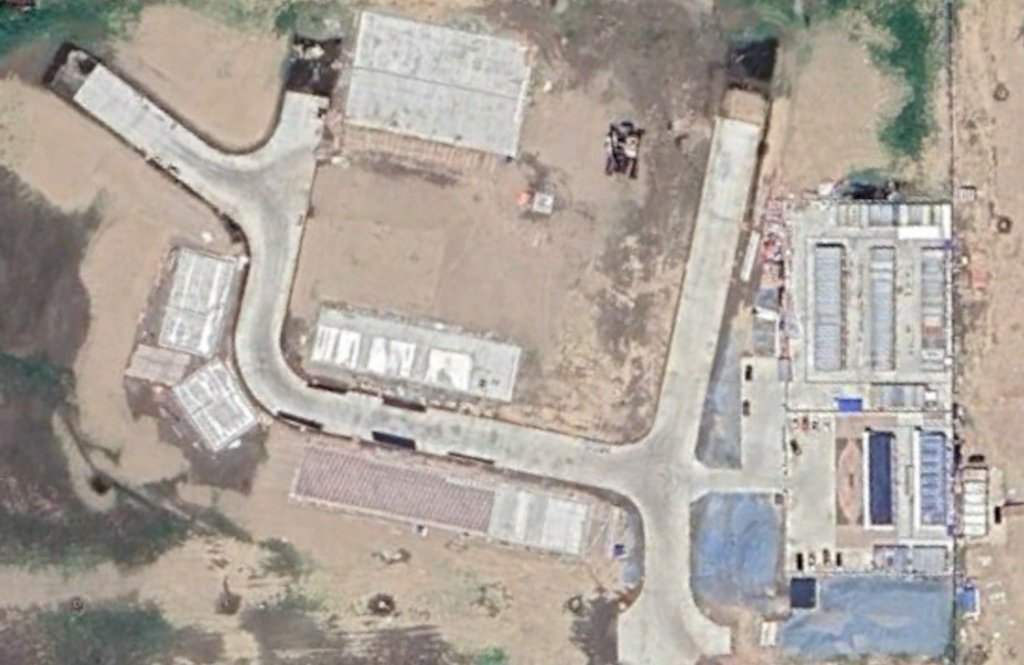
The exact purpose of the site on Changxing Island, which is a major Chinese naval shipbuilding hub, is unknown. Still, as already noted, it is very close to where the Type 076 big deck amphibious warship is under construction. Major work on that ship also looks to have begun last fall just as the site where the GJ-11 mockups have now been observed was being established.

Slightly further to the northwest is also where Fujian was built. Fujian is China’s first catapult-assisted takeoff but arrested recovery (CATOBAR) configured flattop. Images of the Type 076 now under construction indicate that it will have at least one catapult. This has been widely expected since details about the Type 076 first emerged in the early 2020s, which also pointed to a heavy emphasis on drones in its air wing.
Fujian has electromagnetic aircraft launch system (EMALS) catapults and the Type 076 is expected to use a similar, if not identical design. EMALS can be more finely tuned in terms of the force they exert on aircraft at launch than traditional steam-powered catapults. This reduces wear and tear, but also expands the range of aircraft types, especially on the smaller and lighter end of the spectrum, that can be safely launched. This, in turn, offers particular advantages for getting drones of various sizes into the air, and in some cases, makes it possible for certain types to be used from a ship at all.
The video in the social media post below shows initial testing of Fujian’s catapults in port last year.
All this being said, the site at Changxing Island is clearly not a catapult test facility, of which China has several, at least in its present form. Other kinds of testing of and training related to new aircraft intended to operate from carriers and amphibious assault ships, including just exploring what would be involved in maneuvering them around a flight deck, at land-based sites is also common. When it comes to the GJ-11 specifically, satellite imagery emerged last year showing another apparent mockup of one of these UCAVs at a well-known full-size aircraft carrier test facility in Wuhan.
Deck handling on carriers and amphibious assault ships can be a complicated proposition, to begin with, given space constraints and other factors that personnel at bases on land do not have to contend with. Drones, with no pilot inside to help in getting them around, only add new complexities since they have to be moved remotely.
Northrop Grumman, for instance, developed a glove-like apparatus for deck crews to use to go along with its experimental X-47B carrier-capable drones for the U.S. Navy. Boeing has crafted a different kind of portable ground control system for use with the Navy’s future MQ-25 Stingray tanker drones. Ultimately, drones capable of operating from big deck ships could move around with some autonomy. Lockheed Martin’s Skunk Works notably used its X-44 drone to evaluate visual cueing systems as part of its pitch for the program that led to the MQ-25. Altogether, the Chinese have a clear need for facilities to support testing and allow for training on shipboard drone handling.
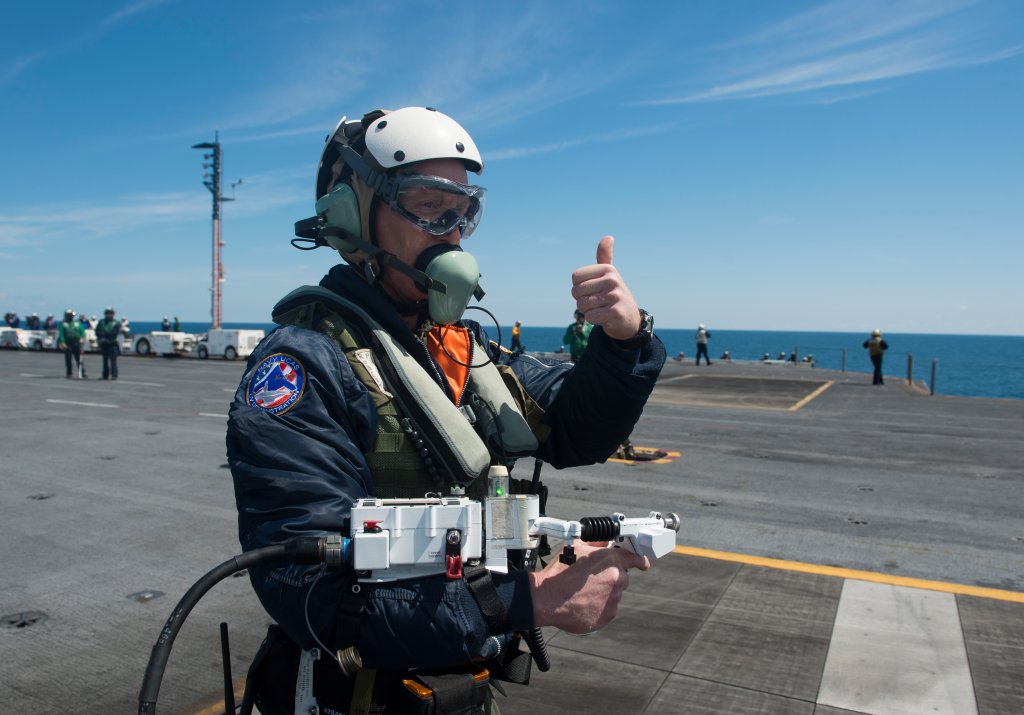
Reports about the potential for carrier-based variants or derivatives of the GJ-11, specifically, which could be used to perform unarmed reconnaissance and in other roles, are not new, tracing back to at least 2019. The state-run Aviation Industry Corporation of China (AVIC) also showed a promotional video at the Zhuhai Airshow in 2021 depicting a navalized version of the GJ-11 taking off what appeared at the time to be a Type 075 amphibious assault ship. The Sharp Sword’s manufacturer, Hongdu Aviation Industry Group, is a subsidiary of AVIC.
The 2021 AVIC video, seen below, also depicted GJ-11s employing either electronic warfare systems or directed energy weapons, as well as air-launched decoys, in swarming attacks on hostile surface warships. The War Zone has highlighted in the past how even unarmed Sharp Swords could be important additions to carrier air wings given their ability to extend the targeting capabilities of friendly forces, as well as provide additional intelligence, surveillance, and reconnaissance capabilities.
As The War Zone wrote after the appearance of the apparent GJ-11 mockup at the carrier test site in Wuhan:
“Having a stealthy carrier drone that’s able to acquire high-priority targets — in particular, U.S. Navy carrier strike groups and other allied vessels — and then offer near-real-time targeting data would be a major boost to China’s already significant anti-access and area-denial capabilities. In such a scenario, a carrier-based GJ-11 might feed targeting data to both anti-ship ballistic missiles and long-range anti-ship cruise missiles, as well as crewed strike aircraft.”
“While a carrier-based ISR version of the GJ-11 would be a very useful addition to the PLAN air wing, an armed variant would also be a hugely significant asset.”

An armed navalized GJ-11 would also represent a capability not currently found anywhere else in the world. This includes the United States, where the U.S. Navy has at least deferred any such plans to an unspecified point in the future.
Electronic warfare, as already highlighted, as well as serving as uncrewed tanker for other aircraft (like the U.S. Navy’s MQ-25 Stingray), could also be potential future roles for a navalized GJ-11 capable of operating from carriers and large amphibious assault ships. Crewed-uncrewed teaming with future aircraft like the stealthy J-35 could well be in the Sharp Sword’s future, too. The PLA’s massive interest and investment in various tiers of uncrewed aircraft for use in all domainsis also well established.
It is possible that the appearance of the GJ-11 mockups on Changxing Island site is unrelated to China’s naval aviation ambitions. However, this seems extremely unlikely given its proximity to the naval shipyards on the island directly involved in building ships like Fujian and the Type 076, as well as the Sharp Sword’s now long-standing naval connections.
With satellite imagery indicating that construction at the Changxing Island site may still be ongoing, more insights into the specific work being done there may emerge in the future. If nothing else, this is just the newest sign that the PLA is moving ever closer to integrating a stealthy jet-powered drone into the air wings of its carriers and amphibious assault ships, including the forthcoming Type 076.
Special thanks to Andreas Rupprecht, an expert on Chinese aerospace and contributor to The War Zone, and to user @foolsball on X for bringing the Google Earth imagery of the Changxing Island site to our attention!
Contact the author: joe@twz.com
